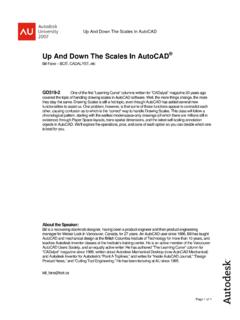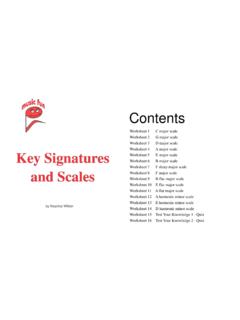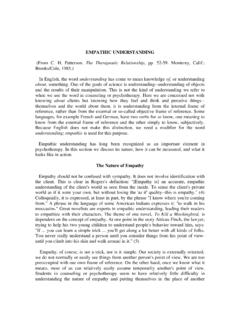Transcription of Developing Checklists and Rating Scales - …
1 Developing . Checklists . ANDRATING. Scales . This job aid describes how to assess student performance or products using Checklists and Rating Scales . This job aid will help you to: select the appropriate tool based on the learning outcome create well-designed Checklists and Rating Scales ensure objectivity and fairness in Checklists and Rating Scales Instructional Job Aid | Developing Checklists and Rating Scales Assessing performance or products Traditional tests are valuable but are primarily for assessing knowledge, not performance or products. When assessing performance, you must observe the student actually performing the task, such as in a driving or swimming test, where there is no product to assess.
2 When assessing a product, it is not necessary to see the student make it. It is the finished product that is important. You can assess a product without knowing who made it, allowing for more objectivity. Common tools used to assess performance or products, both formally and informally, are: Checklists Rating Scales Remember that it is often a good idea for students to assess themselves. This is an excellent learning activity for them and a great time saver for you. Checklists What is a checklist ? A checklist is a tool for identifying the presence or absence of conceptual knowledge, skills, or behaviours. Checklists are used for identifying whether key tasks in a procedure, process, or activity have been completed.
3 The tasks may be a sequence of steps or include items to verify that the correct sequence was followed. You may need to observe the tasks being followed because, in general, you cannot judge what tasks the learner did from the end product. Remember that some attitudes may be indirectly observed. For example, safety attitudes can be observed by seeing if safety equipment is worn. A checklist may also be given to students to follow in completing a procedure ( , in a shop or lab). A checklist itemizes task descriptions in one column and provides a space beside each item in a second column to check off the completion of the task. Characteristics of Checklists Checklists should: have criteria for success based on expected outcomes be short enough to be practical ( , one sheet of paper).
4 Have tasks chunked into logical sections or flow from start to finish highlight critical tasks have sign-off points that prevent students from proceeding without approval, if needed be written with clear, detailed wording to minimize the risk of misinterpretation have space for other information such as the student's name, date, course, examiner, and overall result be reviewed by other instructors Page 2. Instructional Job Aid | Developing Checklists and Rating Scales Note that the criteria for success, based on expected outcomes, provide the indicators for assessing a student's achievement. In some cases, critical criteria must be met for a performance to be judged a success. These criteria often relate to safety issues or critical steps in a process or procedure.
5 checklist example 1: Jack-up procedure ASTP 0001 Shop Tools and Equipment Core Skills Assessment Module 5: Use Shop Tools and Equipment Objective: T. he student will jack up a vehicle safely using the correct equipment for the vehicle. Instructor: _____ Student ID: _____. Student Name: _____ Date: _____. Student Signature: _____. Completed? Using a Floor Jack and Jack Stand 1. S. elect the correct floor jack and stand for the vehicle. 2. B. lock the wheels, set the transmission, and apply the parking brake. 3. I dentify the manufacturer-approved lifting points. 4. P. lace the floor jack under the lifting points _____ STOP! Instructor inspection and initials needed before proceeding. 5. Jack up the vehicle.
6 _____ STOP! Instructor inspection and initials needed before proceeding. 6. L. ower the vehicle, remove the blocks, and return the equipment. Students: Place a check mark in each box when the task is completed. As indicated, ask your instructor to inspect your work and initial this checklist . All steps much be completed. Page 3. Instructional Job Aid | Developing Checklists and Rating Scales checklist example 2: Learning outcomes assessment Expected learning outcome: The student will write learning outcomes that have a measurable action verb at the highest appropriate level given a verb-level list. Criteria for success: All questions must be answered Yes . Yes No Writing Learning Outcomes Does each outcome include an action verb?
7 Is only one action verb used in each outcome? Is each outcome measurable? Is each outcome written in terms of what the learner does, not what the instructor does? Is each outcome clear from the learner's perspective? checklist for Developing a checklist In Developing your checklist , use the following checklist . To develop a checklist : 1. Review the learning outcome and associated criteria for success. 2. State the level of success required for the checklist to be considered completed. In most cases, all items must be checked. 3. Decide on the response such as Yes or No , or simply have a box to be checked once the item has been completed. 4. From a procedure, process, or task description list, pick those items that are required for a good performance or product.
8 5. Group similar items or order them sequentially keep as short as possible. 6. Highlight critical steps, checkpoints, or indicators of success. 7. Write clear instructions for the observer. 8. Review the task descriptions for details and clarity. 9. Format the checklist . 10. Ask for feedback from other instructors before using it with students. Page 4. Instructional Job Aid | Developing Checklists and Rating Scales Rating Scales What is a Rating scale ? A Rating scale is a tool used for assessing the performance of tasks, skill levels, procedures, processes, qualities, quantities, or end products, such as reports, drawings, and computer programs. These are judged at a defined level within a stated range.
9 Rating Scales are similar to Checklists except that they indicate the degree of accomplishment rather than just yes or no. Rating Scales list performance statements in one column and the range of accomplishment in descriptive words, with or without numbers, in other columns. These other columns form the scale and can indicate a range of achievement, such as from poor to excellent, never to always, beginning to exemplary, or strongly disagree to strongly agree. Some tasks, such as procedures and processes, need to be observed in order to be assessed. Characteristics of Rating Scales Rating Scales should: have criteria for success based on expected outcomes have clearly defined, detailed statements This gives more reliable results.
10 For assessing end products, it can sometimes help to have a set of photographs or real samples that show the different levels of achievement. Students can visually compare their work to the standards provided. have statements that are chunked into logical sections or flow sequentially include clear wording with numbers when a number scale is used As an example, when the performance statement describes a behaviour or quality, 1 = poor through to 5 = excellent is better than 1 = lowest through to 5 = highest or simply 1 through 5. The range of numbers should be the same for all rows within a section (such as all being from 1 to 5). The range of numbers should always increase or always decrease. For example, if the last number is the highest achievement in one section, the last number should be the highest achievement in the other sections.












